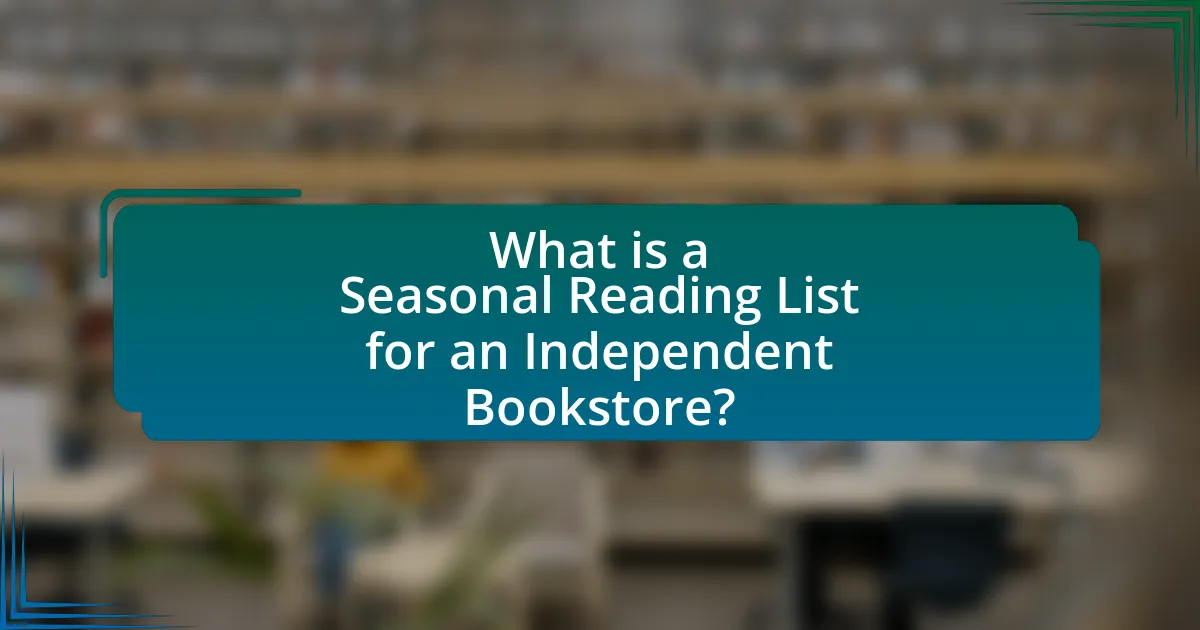A Seasonal Reading List for an Independent Bookstore is a curated collection of books that aligns with the themes and moods of specific seasons, enhancing customer engagement and promoting sales. The article outlines the importance of curation in selecting titles based on market trends, reader preferences, and seasonal themes, while also discussing how these lists can attract diverse customer demographics. It emphasizes the role of customer feedback in shaping seasonal themes and provides strategies for effectively promoting the reading list through social media, in-store events, and collaborations with local authors and schools. Additionally, best practices for maintaining and updating the reading list are highlighted to ensure ongoing relevance and customer satisfaction.

What is a Seasonal Reading List for an Independent Bookstore?
A Seasonal Reading List for an Independent Bookstore is a curated selection of books that reflects themes, genres, or events relevant to a specific season, such as summer, fall, winter, or spring. This list is designed to engage customers by highlighting new releases, seasonal favorites, or books that resonate with the mood and activities associated with that time of year. For example, a summer reading list may include light-hearted novels or beach reads, while a winter list might feature cozy mysteries or holiday-themed stories. Seasonal reading lists help bookstores promote sales, enhance customer experience, and foster community engagement through themed events or discussions.
How does a seasonal reading list enhance customer experience?
A seasonal reading list enhances customer experience by providing curated content that aligns with current themes and events, making the shopping experience more relevant and engaging. This approach allows customers to discover books that resonate with their interests during specific times of the year, such as holidays or seasonal changes. Research indicates that personalized recommendations can increase customer satisfaction and loyalty, as seen in a study by the Journal of Retailing, which found that tailored offerings significantly boost consumer engagement. By offering a seasonal reading list, bookstores can create a sense of community and connection, encouraging customers to return for new selections that reflect their evolving tastes and seasonal moods.
What factors influence the selection of titles for each season?
The selection of titles for each season is influenced by market trends, seasonal themes, and reader preferences. Market trends dictate which genres or topics are gaining popularity, often driven by current events or cultural phenomena. Seasonal themes, such as holidays or seasonal changes, guide the choice of titles that resonate with the time of year, like cozy reads for winter or beach novels for summer. Reader preferences, shaped by feedback and sales data, help bookstores curate a list that aligns with their audience’s interests, ensuring relevance and appeal.
How can seasonal themes attract different customer demographics?
Seasonal themes can attract different customer demographics by aligning book selections with the interests and cultural practices associated with specific times of the year. For instance, during the winter holidays, customers may be drawn to heartwarming stories or festive-themed literature, appealing to families and gift shoppers. In contrast, summer themes might focus on adventure and travel, attracting younger audiences and vacationers seeking escapism. Research indicates that 70% of consumers are influenced by seasonal marketing, highlighting the effectiveness of tailored themes in engaging diverse groups. By curating a reading list that reflects these seasonal interests, independent bookstores can effectively cater to varying customer preferences and increase foot traffic.
Why is curation important for independent bookstores?
Curation is important for independent bookstores because it enhances the shopping experience by providing a thoughtfully selected range of books that reflect the store’s identity and cater to its community’s interests. This tailored selection helps differentiate independent bookstores from larger retailers, fostering customer loyalty and engagement. Research indicates that 70% of consumers prefer shopping at stores that offer personalized experiences, which curation directly supports by showcasing unique titles and local authors. Additionally, effective curation can drive sales by highlighting trending genres or seasonal themes, ultimately contributing to the bookstore’s financial sustainability.
What role does curation play in promoting local authors?
Curation plays a crucial role in promoting local authors by selectively highlighting their works, thereby increasing visibility and accessibility to readers. By carefully choosing which local titles to feature, bookstores can create a platform that showcases the unique voices and stories of their community. This targeted promotion not only fosters a sense of local pride but also encourages readers to engage with and support their local literary scene. Studies have shown that curated lists can significantly boost sales for featured authors, as seen in independent bookstores that report increased interest in local titles when they are prominently displayed.
How does curation impact sales and inventory management?
Curation significantly enhances sales and inventory management by ensuring that the selection of products aligns with customer preferences and seasonal trends. By carefully selecting titles that resonate with the target audience, bookstores can increase customer engagement and drive sales. For instance, a study by the Book Industry Study Group found that curated selections can lead to a 30% increase in sales for featured titles during peak seasons. Additionally, effective curation helps optimize inventory levels by reducing overstock and ensuring that popular titles are readily available, thus minimizing the risk of lost sales opportunities. This strategic approach to inventory management allows bookstores to respond swiftly to market demands, ultimately improving profitability.

What steps are involved in curating a seasonal reading list?
Curating a seasonal reading list involves several key steps. First, identify the seasonal themes or events that resonate with your target audience, such as holidays or seasonal changes. Next, select a diverse range of books that align with these themes, ensuring a mix of genres and authors to appeal to various reader preferences. After selecting the books, create engaging descriptions and recommendations for each title to enhance customer interest. Finally, promote the reading list through in-store displays, social media, and newsletters to reach a wider audience. This structured approach ensures that the reading list is relevant, appealing, and effectively marketed to customers.
How do you identify key themes for each season?
To identify key themes for each season, analyze seasonal trends, cultural events, and reader preferences. Seasonal trends can include holidays, weather changes, and significant dates that influence reading habits, such as summer vacations or winter holidays. Cultural events, like festivals or anniversaries, provide context for thematic selections, while reader preferences can be gauged through sales data, customer feedback, and popular genres during specific times of the year. For example, romance novels often peak around Valentine’s Day, while horror titles may be more popular in October. This method ensures that the selected themes resonate with the target audience and align with broader cultural narratives.
What resources can help in theme identification?
Resources that can help in theme identification include literary databases, genre-specific guides, and reader surveys. Literary databases, such as Goodreads and LibraryThing, provide insights into popular themes and trends based on user ratings and reviews. Genre-specific guides, like those published by the American Library Association, offer curated lists that highlight thematic elements relevant to specific genres. Reader surveys can also be instrumental, as they gather direct feedback from customers about their preferences, helping bookstores align their selections with current interests. These resources collectively enhance the ability to identify and curate themes effectively for a seasonal reading list.
How can customer feedback shape seasonal themes?
Customer feedback can significantly shape seasonal themes by providing insights into reader preferences and trends. When customers express their interests, such as a desire for specific genres or topics during particular seasons, bookstores can tailor their selections accordingly. For instance, if feedback indicates a growing interest in cozy mysteries during the fall, a bookstore can prioritize these titles in their seasonal displays. Additionally, analyzing customer reviews and sales data can reveal which themes resonate most, allowing bookstores to curate a reading list that aligns with customer expectations and enhances sales. This approach not only meets customer demand but also fosters a sense of community engagement, as readers feel their voices influence the bookstore’s offerings.
What criteria should be used to select books for the list?
To select books for the list, criteria should include relevance to the season, diversity of genres, and popularity among target customers. Relevance ensures that the books resonate with seasonal themes or events, such as holiday reads in December or beach novels in summer. Diversity of genres caters to varied customer preferences, enhancing the appeal of the list. Popularity can be assessed through sales data, reviews, and recommendations, ensuring that the selected titles are likely to attract interest and drive sales.
How do genre and audience preferences influence book selection?
Genre and audience preferences significantly influence book selection by guiding the types of books that resonate with specific reader demographics. For instance, a bookstore targeting young adults may prioritize genres like fantasy or contemporary fiction, as surveys indicate that these genres are popular among that age group. According to a 2021 report by the American Booksellers Association, 60% of young adult readers prefer fantasy, which informs bookstores to stock more titles in that genre to meet demand. Additionally, audience preferences can dictate seasonal selections; for example, romance novels often see increased sales around Valentine’s Day, prompting bookstores to curate themed displays. Thus, understanding genre trends and audience demographics is essential for effective book selection in independent bookstores.
What role do reviews and ratings play in the selection process?
Reviews and ratings significantly influence the selection process by providing insights into the quality and appeal of books. They serve as a form of social proof, helping potential readers gauge the popularity and credibility of titles. Research indicates that 79% of consumers trust online reviews as much as personal recommendations, highlighting their impact on purchasing decisions. Additionally, books with higher ratings are more likely to be selected for display and promotion in independent bookstores, as they are perceived to have a greater likelihood of satisfying customer preferences.

How can you effectively promote your seasonal reading list?
To effectively promote your seasonal reading list, utilize social media platforms to engage your audience and showcase featured titles. Research indicates that 73% of consumers are influenced by social media when making purchasing decisions, highlighting its importance in reaching potential readers. Create visually appealing posts that include book covers, brief descriptions, and personal recommendations to attract attention. Additionally, consider hosting events such as book signings or themed reading nights to create community interest and drive foot traffic to your bookstore. Collaborating with local influencers or book clubs can further amplify your reach, as their endorsements can lend credibility and attract new customers.
What marketing strategies work best for seasonal reading lists?
Effective marketing strategies for seasonal reading lists include targeted social media campaigns, email newsletters, and in-store displays. Targeted social media campaigns leverage platforms like Instagram and Facebook to showcase seasonal titles, utilizing visually appealing graphics and engaging captions to attract readers. Email newsletters can highlight curated lists, offering personalized recommendations based on customer preferences, which increases engagement and sales. In-store displays should be strategically placed to catch customers’ attention, featuring seasonal themes and prominently displaying featured books. These strategies are supported by data indicating that personalized marketing can increase customer retention by up to 80%, demonstrating their effectiveness in driving sales for seasonal reading lists.
How can social media be leveraged to promote the reading list?
Social media can be leveraged to promote the reading list by creating engaging content that highlights featured books and encourages community interaction. Utilizing platforms like Instagram and Facebook, bookstores can share visually appealing posts, including book covers and quotes, to attract attention. Additionally, hosting live discussions or Q&A sessions about the reading list can foster engagement and build a community around the bookstore. According to a 2021 survey by the Pew Research Center, 69% of adults in the U.S. use social media, making it an effective channel for reaching a broad audience.
What in-store events can enhance visibility for the seasonal list?
In-store events such as author signings, themed book clubs, and seasonal reading festivals can significantly enhance visibility for the seasonal list. Author signings attract fans and create buzz around specific titles, while themed book clubs encourage community engagement and discussion around the seasonal selections. Seasonal reading festivals can showcase multiple titles, drawing in larger crowds and increasing foot traffic. According to a study by the American Booksellers Association, bookstores that host regular events see a 20% increase in customer visits, demonstrating the effectiveness of such activities in promoting visibility.
How can collaboration with local authors and publishers enhance your list?
Collaboration with local authors and publishers can significantly enhance your reading list by introducing unique, regionally relevant titles that resonate with the community. This partnership fosters a sense of local identity and pride, attracting customers who are interested in supporting homegrown talent. Additionally, local authors often have insights into the cultural and historical context of their works, which can enrich the reading experience for customers. According to a study by the American Booksellers Association, independent bookstores that feature local authors see a 30% increase in foot traffic during events such as book signings and readings, demonstrating the tangible benefits of such collaborations.
What benefits come from hosting author events related to the seasonal list?
Hosting author events related to the seasonal list enhances customer engagement and drives sales. These events create a direct connection between authors and readers, fostering a sense of community and excitement around new releases. According to a study by the American Booksellers Association, bookstores that host author events see an increase in foot traffic and sales, with 70% of attendees purchasing books during or after the event. Additionally, author events can generate media coverage and social media buzz, further promoting the bookstore and its seasonal offerings.
How can partnerships with local schools or libraries promote the reading list?
Partnerships with local schools or libraries can effectively promote the reading list by facilitating access to a wider audience and enhancing community engagement. Schools can incorporate the reading list into their curriculum or extracurricular activities, encouraging students to explore recommended titles. Libraries can host events, such as book clubs or author readings, centered around the reading list, attracting patrons and fostering a love for reading. Research indicates that community-based reading initiatives can increase literacy rates and reading frequency among participants, demonstrating the positive impact of such partnerships on promoting literature within the community.
What are some best practices for maintaining a seasonal reading list?
To maintain a seasonal reading list effectively, regularly update the list based on seasonal themes, reader preferences, and new releases. This practice ensures that the reading list remains relevant and engaging for customers. For instance, incorporating books that align with holidays or seasonal events can attract more interest. Additionally, gathering feedback from customers about their reading preferences can help tailor the list to meet their interests. Research indicates that bookstores that actively engage with their community and adapt their offerings see increased customer satisfaction and sales.
How often should the reading list be updated and why?
The reading list should be updated at least once per season to reflect new releases, trends, and customer preferences. Seasonal updates ensure that the reading list remains relevant and engaging, catering to the evolving interests of customers and incorporating timely themes or events. For instance, a study by the American Booksellers Association indicates that bookstores that frequently refresh their offerings see a 20% increase in customer engagement and sales. This practice not only attracts repeat customers but also positions the bookstore as a knowledgeable and current resource in the literary community.
What methods can be used to gather ongoing customer feedback?
Surveys and feedback forms are effective methods to gather ongoing customer feedback. These tools can be distributed through email, social media, or in-store, allowing customers to share their opinions on book selections and store experiences. Research indicates that 70% of customers prefer to provide feedback through online surveys, highlighting their effectiveness in capturing customer insights. Additionally, implementing suggestion boxes in-store encourages spontaneous feedback, fostering a continuous dialogue with customers about their preferences and needs.


